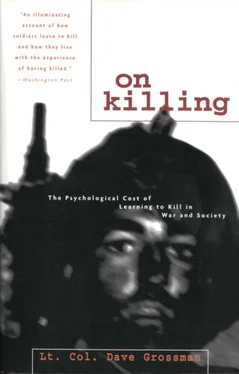At a lower level are the vicarious role models who kill without even the tissue of any apparent justification whatsoever. Having been desensitized by the kinds of movies outlined above, a portion of our population is then willing to accept role models who kill entirely without reason. The vicarious reinforcement here is not even vengeance for supposed social slights, but simply slaughter and suffering for its own sake and, ultimately, for the sake of power.
Notice the sequence in this downward spiral of vicarious role models. We began with those who killed within the constraints of the law. Somewhere along the line we began to accept role models who “had” to go outside the law to kill criminals who we know “deserved to die,” then vicarious role models who killed in retribution for adolescent social slights, and then role models who kill completely without provocation or purpose.
At every step of the way we have been vicariously reinforced by the fulfillment of our darkest fantasies. This new breed of role models also has social power: the power to do whatever they want in a society depicted as evil and deserving of punishment. These role models transcend the rules of society, which results in great “status” to be envied by a portion of society that has come to adore this new breed of celebrity. And of course we have observed a similarity to the learner in the role model’s rage. A rage felt by most human beings toward the slights and perceived crimes inflicted upon them by their society, but which is particularly intense in adolescence.
The increase in divorces, teenage mothers, and single-parent families in our society has often been noted and lamented, but a little-noted side effect of this trend has been to make America’s children even more susceptible to this new breed of violent role models. In the traditional nuclear family there is a stable father figure who serves as a role model for young boys. Boys who grow up without a stable male figure in their lives are desperately seeking a role model. Strong, powerful, high-status role models such as those offered in movies and on television fill the vacuum in their lives. We have taken away their fathers and replaced them with new role models whose successful response to every situation is violence. And then we wonder why our children have become ever more violent.
CHAPTER FIVE
The Resensitization of America
Throughout this book we have observed the relevant factors in military training. Men are recruited at a psychologically malleable age. They are distanced from their enemy psychologically, taught to hate and dehumanize. They are given the threat of authority, the absolution and pressure of groups. Even then they are resistant and have trouble killing. They shoot in the air; they find nonviolent tasks to occupy them. And so they still need to be conditioned. The conditioning is astoundingly effective, but there is a psychological price to pay.
In this last section we have applied what we have learned about killing on the battlefield in order to gain an understanding of killing in our society. Violent movies are targeted at the young, both men and women, the same audience the military has determined to be most susceptible for its killing purposes. Violent video games hardwire young people for shooting at humans. The entertainment industry conditions the young in exactly the same way the military does. Civilian society apes the training and conditioning techniques of the military at its peril.
Add to this the dissolution of the family. Children from all economic strata no longer have a censor, counsel, or role model at home. They turn to their peers as authority figures. In some cases they find a family in gangs.
And then there are factors that provide psychological distance in our society. American society is increasingly divided along lines of race, gender, and so on. It has become compartmentalized. People in ghettos rarely leave their own areas — the larger world, the larger country is foreign land. The reverse is true with middle and upper classes. They travel everywhere except for impoverished areas — which they avoid anxiously. It is quite easy to maintain this distance. They ride in their cars; they live in the suburbs and eat in nice restaurants. The separation is not as strident as the soldier who learns to think of his enemy as an animal or refer to him as a “gook,” but there is distance.
The only connecting point in our society is the media. The media, which should act to bring us together, serves to pull us apart: conditioning and teaching violence, nurturing our darkest instincts, and feeding the nation with violent stereotypes that foster our deepest fears.
We are most assuredly on the road to ruin, and we need desperately to find the road home from this dark and fearful place to which we have traveled.
And in that state of nature, no arts; no letters; no society; and which is worst of all, continual fear and danger of violent death; and the life of man, solitary, poor, nasty, brutish, and short.
— Thomas Hobbes
Leviathan
Some would claim that modern, ultraviolent movies and their video-game equivalents examined here serve as a form of sublimation that will make violence and war obsolete. “Sublimation” is a term coined by Sigmund Freud referring to the turning of unacceptable urges and desires toward something socially desirable: taking the dark, unacceptable drives of the id and diverting them toward the sublime. Thus someone with a desire to slice open bodies may become a surgeon, or someone with an unacceptable urge toward violence may channel it toward sports, the military, or law enforcement. But watching movies is not sublimation.
The entertainment industry is not providing a socially acceptable channeling of energy. Indeed, very little energy is generally spent in the passive reception of television and movies. And this hardly qualifies as a socially acceptable or desirable channel for energies. Unless it has become socially desirable to kill outside the authority of the law, or to murder innocent victims — which, in the twisted world of the entertainment industry, it has.
If violence in television and movies were a form of sublimation, and if it were at all effective, then per capita violence should be going down. Instead it has multiplied nearly seven times in the span of the same generation in which this supposed sublimation has become available. It is not sublimation, or even neutral entertainment. It is classical conditioning, operant conditioning, and social learning, all focused toward the violence enabling of an entire society.
When our 1992 Olympic hockey team displayed a degree of lawlessness, violence, and aggression never before seen in such competitions, we should have begun to wonder. When the mother of one high school cheerleader was convicted of hiring a hit man to murder her daughter’s competitor for the cheerleader squad, and when the “bodyguard” for one Olympic figure skater attempted to eliminate the competition by maiming an opponent, we should have begun to understand that this is a society that is increasingly conditioned to turn to violence as the answer to all of its difficulties.
And the Road Home: The Resensitization of America
Male power, male dominance, masculinity, male sexuality, male aggression are not biologically determined. They are conditioned…. What is conditioned can be deconditioned. Man can change.
— Catherine Itzin
Pornography: Women, Violence and Civil Liberties
So what is the answer? Which is the road home from this dark and fearful place to which we have traveled?
Perhaps it is time to begin the “resensitization” of America.
Читать дальше







